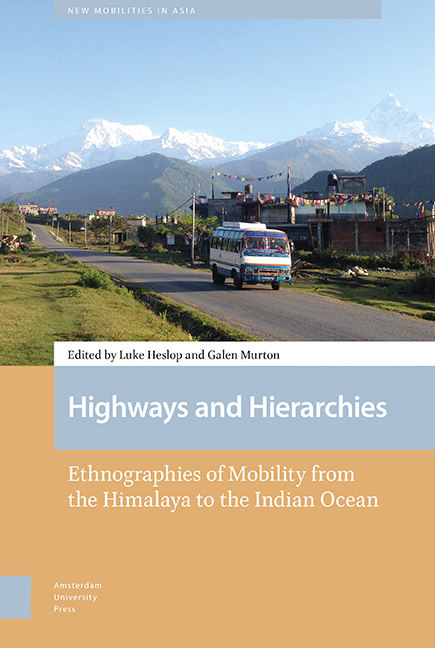Book contents
- Frontmatter
- Contents
- List of figures
- Acknowledgements
- Preface: Thinking with roads
- 1 Why highways remake hierarchies
- 2 Stuck on the side of the road: Mobility, marginality, and neoliberal governmentality in Nepal
- 3 A road to the ‘hidden place’: Road building and state formation in Medog, Tibet
- 4 Dhabas, highways, and exclusion
- 5 The edge of Kaladan: A ‘spectacular’ road through ‘nowhere’ on the India-Myanmar borderlands
- 6 The making of a ‘new Dubai’: Infrastructural rhetoric and development in Pakistan
- 7 Encountering Chinese development in the Maldives: Gifts, hospitality, and rumours
- 8 Roads and the politics of thought: Climate in India, democracy in Nepal
- Authors notes
- Index
7 - Encountering Chinese development in the Maldives: Gifts, hospitality, and rumours
Published online by Cambridge University Press: 13 November 2021
- Frontmatter
- Contents
- List of figures
- Acknowledgements
- Preface: Thinking with roads
- 1 Why highways remake hierarchies
- 2 Stuck on the side of the road: Mobility, marginality, and neoliberal governmentality in Nepal
- 3 A road to the ‘hidden place’: Road building and state formation in Medog, Tibet
- 4 Dhabas, highways, and exclusion
- 5 The edge of Kaladan: A ‘spectacular’ road through ‘nowhere’ on the India-Myanmar borderlands
- 6 The making of a ‘new Dubai’: Infrastructural rhetoric and development in Pakistan
- 7 Encountering Chinese development in the Maldives: Gifts, hospitality, and rumours
- 8 Roads and the politics of thought: Climate in India, democracy in Nepal
- Authors notes
- Index
Summary
Abstract
This chapter examines the longest and most developed road in the Maldives archipelago, a fifteen-kilometre-long link road connecting four islands of the Laamu (or Haddummati) Atoll. In the planning phase, there were tensions between those who argued that the road should connect houses to the school and the mosque and those who argued that the road should connect the harbour to the market. Such appeals, bifurcated along gender lines, reflect local mobility concerns and were tied to existing political rifts between the four islands that were intensified by the appearance of a new infrastructural asset. The built road facilitates a multitude of local encounters as people travel further and more regularly, but it is also through the road that islanders encounter the global forces of capital and construction that shape their islands. The Laamu link road was a ‘gift’ from the Chinese government, constructed by the Jiangsu Transportation Engineering Group (JTEG), and amidst local mobility concerns and inter-island politics swirl rumours and hearsay of land grabs and international power struggles between China, India, the US, and Saudi Arabia. This chapter, as well as being an ethnographic exposition of Chinese infrastructure development in a South Asian archipelago, explores the road as a social experience as it crosscuts competing visions of modernity, global connectivity, and anxiety about material change on remote coral atolls in the Indian Ocean.
Keywords: Maldives, encounter, geopolitics, rumour, gifts, link road
Foreign encounters and changing infrastructure
Approximately 67 million years ago, the tectonic plate of what is now the Indian subcontinent drifted northward over a particularly hot part of the Earth's mantle, stretching from Reunion to the Deccan Traps of India, and sprouted a row of volcanoes, which later cooled and subsided. For millennia, coral has grown atop this sunken oceanic plateau, the Chagos- Lakshadvip (formerly Laccadive) volcanic ridge, which stretches from the Chagos Archipelago to the Lakshadvip Sea off the coast of Kerala. As the volcanoes subsided, they left upwardly growing fringing coral that had formed around the peaks where they touched the surface of the water (Darwin 1842).
- Type
- Chapter
- Information
- Highways and HierarchiesEthnographies of Mobility from the Himalaya to the Indian Ocean, pp. 175 - 196Publisher: Amsterdam University PressPrint publication year: 2021



